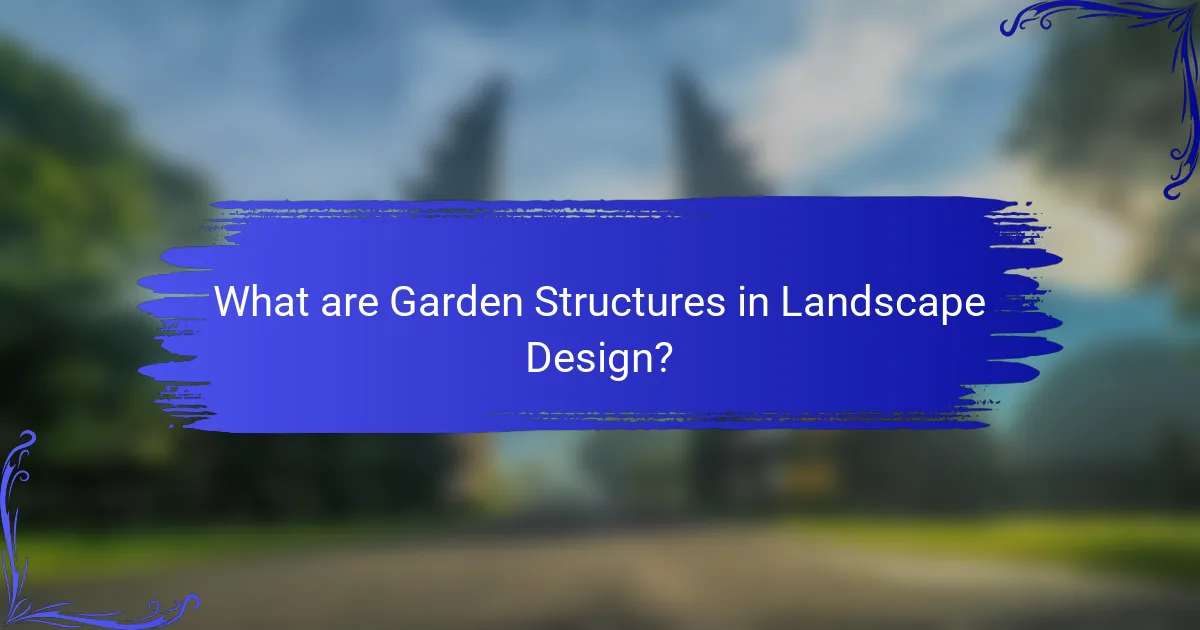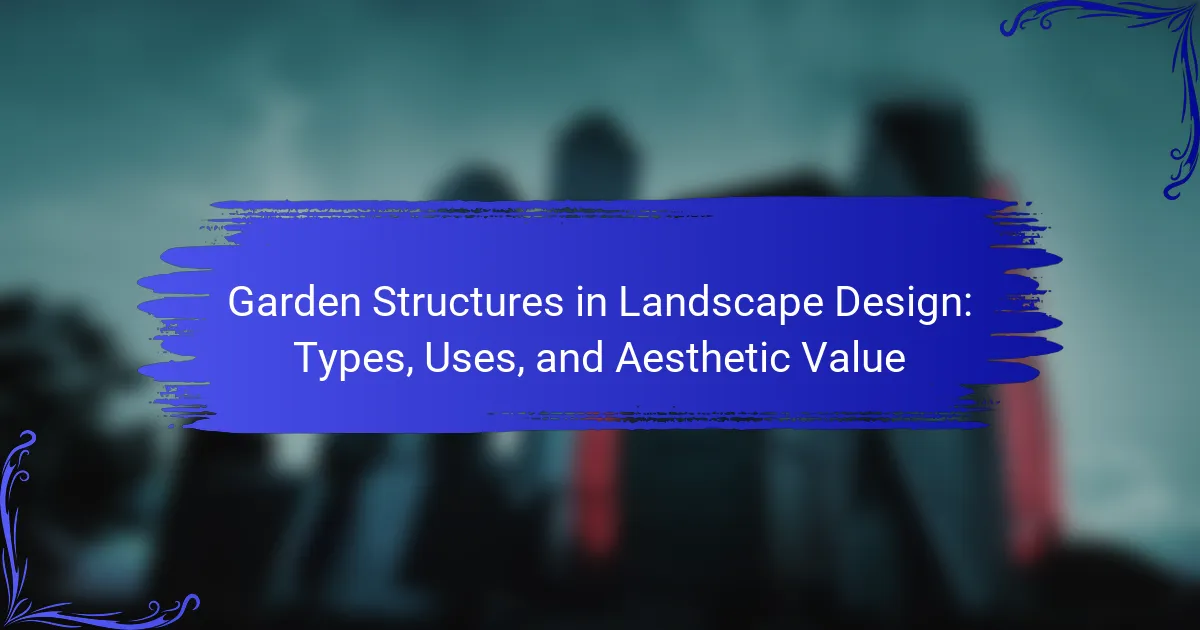Garden structures are architectural elements that enhance outdoor spaces in landscape design. This article explores various types of garden structures, including pergolas, gazebos, trellises, and arbors, highlighting their functional benefits such as providing shade and supporting climbing plants. Additionally, it discusses the aesthetic value these structures bring to gardens, with historical examples illustrating their significance from ancient civilizations to modern design. The integration of garden structures is shown to improve design coherence and usability, making them essential components in creating defined spaces and focal points within landscapes.

What are Garden Structures in Landscape Design?
Garden structures in landscape design are architectural elements that enhance outdoor spaces. They include features such as pergolas, gazebos, trellises, and arbors. These structures provide functional benefits like shade and support for climbing plants. They also contribute to the aesthetic appeal of gardens. Historical use of garden structures dates back to ancient civilizations, showcasing their enduring significance. For example, the Romans used pergolas in their gardens for both beauty and utility. Garden structures can define spaces and create focal points in landscape design. Their integration into garden layouts can improve overall design coherence and usability.
How do Garden Structures enhance outdoor spaces?
Garden structures enhance outdoor spaces by providing functional and aesthetic benefits. They create defined areas for activities such as dining, relaxation, or gardening. Structures like pergolas and gazebos offer shade and shelter, improving comfort during outdoor gatherings. Additionally, these features can serve as focal points, drawing attention and enhancing visual appeal. They also support plant growth, such as climbing vines, adding greenery and texture. Studies show that well-designed structures can increase property value by up to 15%. Overall, garden structures contribute to the usability and beauty of outdoor environments.
What are the primary functions of Garden Structures?
Garden structures primarily serve to enhance functionality, aesthetics, and organization in outdoor spaces. They provide support for plants, such as trellises for climbing vines. Garden structures also create defined areas, like pergolas and arbors, which can delineate spaces for seating or dining. Additionally, they offer shelter and shade, improving comfort and usability in gardens. Structures like gazebos provide a focal point and encourage social interaction. They can also contribute to biodiversity by creating habitats for various species. Furthermore, garden structures can improve property value by enhancing the overall landscape design.
How do Garden Structures contribute to landscape aesthetics?
Garden structures enhance landscape aesthetics by providing visual interest and focal points. They can define spaces within a garden, creating a sense of organization. Structures like pergolas, trellises, and arbors add height and dimension to flat landscapes. Additionally, they serve as backdrops for plants, enhancing their colors and forms. The materials used in these structures, such as wood or metal, contribute texture and contrast to the garden. Their design can reflect architectural styles, creating harmony with surrounding buildings. Research shows that well-designed garden structures can increase property value by up to 15%. This integration of structures into landscape design promotes a cohesive and appealing outdoor environment.
What types of Garden Structures exist?
There are several types of garden structures. Common examples include pergolas, arbors, gazebos, trellises, and garden sheds. Pergolas are open structures that provide partial shelter and support climbing plants. Arbors are similar but are often smaller and serve as entryways. Gazebos are freestanding, roofed structures offering complete shelter and seating. Trellises are vertical supports for climbing plants, enhancing vertical space. Garden sheds are functional buildings for storage and gardening tools. Each structure serves a unique purpose in enhancing garden aesthetics and functionality.
What are the most common types of Garden Structures?
The most common types of garden structures include trellises, pergolas, arbors, gazebos, and sheds. Trellises support climbing plants and can enhance vertical space. Pergolas provide partial shelter and are often used for outdoor seating areas. Arbors serve as gateways and can frame pathways or entrances. Gazebos offer a shaded space for relaxation and gatherings. Sheds are functional structures for storage and gardening tools. Each structure serves specific purposes while contributing to the overall aesthetics of a garden.
How do different types of Garden Structures serve various purposes?
Different types of garden structures serve various purposes by providing functionality, aesthetics, and environmental benefits. Arbors and trellises support climbing plants, enhancing vertical space and visual interest. Gazebos offer shaded areas for relaxation and gatherings, increasing outdoor usability. Garden sheds provide storage for tools and equipment, promoting organization. Fences create boundaries and privacy, while also serving as decorative elements. Raised beds improve soil drainage and accessibility for gardening. Pergolas provide partial shade and support for vines, adding architectural appeal. Each structure contributes uniquely to the overall landscape design, fulfilling specific roles while enhancing the garden’s beauty.
Why are Garden Structures important in landscape design?
Garden structures are important in landscape design because they enhance functionality and aesthetics. They provide support for plants, create defined spaces, and serve as focal points. Structures like trellises and arbors can increase vertical gardening opportunities. This maximizes space and adds visual interest. Additionally, garden structures can improve microclimates and provide shelter. For example, pergolas offer shade and reduce heat exposure. The integration of these elements can lead to more diverse and engaging outdoor environments. Overall, garden structures contribute significantly to the overall design and usability of landscapes.
How do Garden Structures influence the overall design of a garden?
Garden structures significantly influence the overall design of a garden by providing framework and focal points. They enhance visual interest and create defined spaces within the landscape. Structures such as trellises, pergolas, and arches can guide the eye and draw attention to specific garden areas. They also offer support for climbing plants, which adds verticality and texture. Furthermore, garden structures can provide shelter and shade, making outdoor spaces more usable. For example, a well-placed gazebo can serve as a gathering spot while complementing the surrounding plants. Overall, the strategic use of garden structures contributes to the garden’s aesthetic coherence and functionality.
What role do Garden Structures play in sustainability and ecology?
Garden structures enhance sustainability and ecology by promoting biodiversity and efficient resource use. They provide habitats for wildlife, supporting pollinators and other beneficial organisms. Structures like trellises and arbors can support climbing plants, increasing vertical growth and maximizing space. This vertical gardening reduces land use and promotes urban greening. Rainwater harvesting systems can be integrated into these structures, optimizing water use. Additionally, using sustainable materials for construction reduces environmental impact. Studies show that green roofs and pergolas can improve microclimates, reducing the need for artificial cooling. Overall, garden structures contribute to ecological balance and sustainable practices in landscape design.
How can Garden Structures be integrated into different landscape styles?
Garden structures can be integrated into different landscape styles by aligning their design with the overall aesthetic and functionality of the space. For instance, pergolas can complement a Mediterranean garden by providing shade and support for climbing plants. Arbors can enhance a cottage garden by creating inviting entryways adorned with flowers. In modern landscapes, sleek metal or glass structures can add a contemporary touch. Natural wood structures can blend seamlessly into woodland gardens, promoting a rustic feel. Additionally, water features like gazebos can harmonize with Japanese gardens, fostering tranquility. Each structure should reflect the characteristics of the specific landscape style while serving a practical purpose. This integration enhances visual coherence and functionality within the garden.
What considerations should be taken when choosing Garden Structures?
When choosing garden structures, consider the purpose, materials, and location. The purpose determines the type of structure needed, such as a gazebo for relaxation or a trellis for climbing plants. Materials like wood, metal, or vinyl influence durability and maintenance. Location impacts sunlight exposure and wind protection. Assess the garden’s overall design to ensure harmony with existing elements. Local climate conditions affect the longevity of materials used. Lastly, budget constraints will guide the selection of structure and materials.
What factors affect the selection of materials for Garden Structures?
The selection of materials for garden structures is influenced by durability, aesthetics, and cost. Durability ensures the structure withstands weather conditions and time. Aesthetics relate to how well the material complements the garden’s design. Cost affects budget considerations and overall project feasibility. Environmental impact also plays a role, with sustainable materials gaining preference. Maintenance requirements influence long-term care and upkeep. Local availability of materials can dictate choices due to accessibility. Finally, structural integrity is crucial for safety and functionality of the garden structures.
How do climate and environment impact Garden Structure choices?
Climate and environment significantly influence garden structure choices. Different climates dictate the materials and designs suitable for durability and functionality. For example, in humid climates, structures must resist mold and decay, leading to the use of treated wood or metal. Conversely, in arid regions, materials that withstand heat and minimize water loss are preferred, such as stone or concrete. Additionally, wind patterns can affect the placement and design of structures to ensure stability. Local flora and fauna also play a role; structures may need to accommodate specific plants or deter wildlife. According to the USDA Plant Hardiness Zone Map, understanding local climate conditions is essential for selecting appropriate garden structures.
What are best practices for maintaining Garden Structures?
Regular inspections of garden structures are essential for maintenance. Check for signs of wear, such as rust, rot, or damage. Clean surfaces to prevent mold and mildew buildup. Use appropriate cleaners for different materials, like wood or metal. Apply protective coatings, such as paint or sealant, to extend lifespan. Ensure proper drainage to avoid water pooling around structures. Repair any damage promptly to prevent further issues. Prune surrounding plants to maintain airflow and sunlight exposure. Following these practices can enhance the durability and appearance of garden structures.
How can you prolong the lifespan of Garden Structures?
To prolong the lifespan of garden structures, regular maintenance is essential. This includes inspecting for damage and wear. Wooden structures should be treated with preservatives to prevent rot. Metal structures need rust-resistant paint to avoid corrosion. Proper drainage around structures helps prevent water damage. Additionally, removing debris from roofs and gutters prevents moisture buildup. Using high-quality materials during construction enhances durability. Finally, positioning structures away from harsh weather conditions can reduce wear. These practices significantly extend the functional life of garden structures.
What common issues do Garden Structures face and how can they be resolved?
Garden structures face issues such as weather damage, pest infestations, and structural instability. Weather damage can result from strong winds, heavy rain, or snow. Regular maintenance, including inspections and repairs, helps mitigate this risk. Pest infestations can harm wood and plants; using pest-resistant materials and treatments can prevent this. Structural instability often arises from poor construction or material fatigue. Ensuring proper design and using high-quality materials can resolve this issue.
Garden structures are architectural elements in landscape design that enhance outdoor spaces through features like pergolas, gazebos, trellises, and arbors. These structures provide functional benefits such as shade, support for climbing plants, and defined areas for activities, while also improving the aesthetic appeal of gardens. The article covers various types of garden structures, their roles in enhancing usability and beauty, and their significance in sustainability and ecology. Additionally, it addresses considerations for material selection, maintenance practices, and the impact of climate on structure choices, offering a comprehensive overview of their importance in landscape design.
